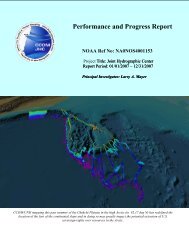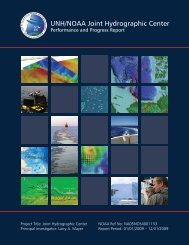Performance and Progress Report - John Doe FIX: put in the authors ...
Performance and Progress Report - John Doe FIX: put in the authors ...
Performance and Progress Report - John Doe FIX: put in the authors ...
You also want an ePaper? Increase the reach of your titles
YUMPU automatically turns print PDFs into web optimized ePapers that Google loves.
The next stage <strong>in</strong> <strong>the</strong> development of this project is <strong>the</strong> application of statistical tools for<br />
count<strong>in</strong>g fish us<strong>in</strong>g high resolution multibeam backscatter. This method, which was<br />
orig<strong>in</strong>ally applied to count<strong>in</strong>g fish us<strong>in</strong>g s<strong>in</strong>gle beam echo sounders, differs from <strong>the</strong><br />
more traditional echo <strong>in</strong>tegration methods <strong>in</strong> that it does not require absolute target<br />
strengths <strong>and</strong> is <strong>in</strong>sensitive to target orientation. The method is essentially based on <strong>the</strong><br />
sc<strong>in</strong>tillation of backscatter from fish <strong>and</strong> shows much promise for high resolution echo<br />
sound<strong>in</strong>g sonars, <strong>in</strong>clud<strong>in</strong>g most multibeam sonars. It is hoped that <strong>the</strong> Georges Bank<br />
herr<strong>in</strong>g data (both 7125 <strong>and</strong> EK60) can be used to test this methodology.<br />
AUV WORK AND THE HARBOR TRACKING AND<br />
OBSERVATORY PROJECT:<br />
In our ongo<strong>in</strong>g effort to explore new approaches to collect hydrographic <strong>and</strong> o<strong>the</strong>r data <strong>in</strong><br />
critical shallow water environments, we have begun to explore <strong>the</strong> applicability of us<strong>in</strong>g a<br />
small Autonomous Underwater Vehicle for collect<strong>in</strong>g critical bathymetric <strong>and</strong> o<strong>the</strong>r data.<br />
We have teamed with Art Trembanis of <strong>the</strong> University of Delaware to obta<strong>in</strong> use of his<br />
FETCH 3 vehicle. We have purchased <strong>and</strong> <strong>in</strong>tegrated small multibeam sonar (Imagenix<br />
Delta-T) <strong>in</strong>to this AUV <strong>and</strong> have begun to explore its applicability for collect<strong>in</strong>g both<br />
hydrographic quality bathymetric data <strong>and</strong> seafloor characterization data. At this po<strong>in</strong>t <strong>in</strong><br />
time we have only had a several days of <strong>in</strong>teraction with <strong>the</strong> vehicle but we are now <strong>in</strong><br />
<strong>the</strong> process of calibrat<strong>in</strong>g <strong>the</strong> sonar <strong>and</strong> develop<strong>in</strong>g control <strong>and</strong> visualization software for<br />
<strong>the</strong> vehicle. In support of this effort as well as to provide a permanent ability to<br />
accurately position this (or any o<strong>the</strong>r) AUV as well as cameras, samplers <strong>and</strong> o<strong>the</strong>r<br />
devices we have begun a project designed to <strong>in</strong>stall a fixed acoustic navigation array <strong>in</strong> a<br />
portion of Portsmouth Harbor. When fully functional, this position<strong>in</strong>g system may also<br />
provide <strong>the</strong> ability to passively listen to ship-traffic <strong>in</strong> <strong>the</strong> harbor as well as to monitor<br />
changes <strong>in</strong> <strong>the</strong> physical oceanography of <strong>the</strong> harbor. We have called this component of<br />
<strong>the</strong> project <strong>the</strong> “Harbor Observatory Project.”<br />
Our effort this year has been two-pronged: 1) conduct<strong>in</strong>g a study to evaluate COTS<br />
hardware for accomplish<strong>in</strong>g this task <strong>and</strong> 2) develop<strong>in</strong>g a home-grown proof-of-concept<br />
system. So far our discussions with commercial vendors have led us to believe that <strong>the</strong>re<br />
is not a simple COTS solution <strong>and</strong> thus most of our effort has been focused on<br />
develop<strong>in</strong>g <strong>the</strong> proof-of-concept system. This system, whose development is under <strong>the</strong><br />
supervision of Tom Weber (with collaboration from McGillicuddy, Huff,<br />
Weirathmueller, Schmidt, Calder <strong>and</strong> Mayer) is based on a bear<strong>in</strong>g-bear<strong>in</strong>g system <strong>and</strong> is<br />
essentially a hybrid between an ultra-short basel<strong>in</strong>e system <strong>and</strong> a long basel<strong>in</strong>e system.<br />
We have built a proof-of-concept system (<strong>in</strong>clud<strong>in</strong>g design <strong>and</strong> construction of preamps,<br />
assembly of hydrophone system, <strong>and</strong> <strong>in</strong>tegration with a data acquisition system) that<br />
demonstrates a remarkably accurate bear<strong>in</strong>g measur<strong>in</strong>g capability (σθ ~ 0.1°) <strong>in</strong> tank<br />
test<strong>in</strong>g.<br />
A field test of this system (conducted with <strong>the</strong> help of <strong>the</strong> Coastal Surveyor <strong>and</strong> Ben<br />
Smith, Michelle Weirathmueller, Val Schmidt, Andy McLeod, <strong>and</strong> Kurt Schwehr) was<br />
conducted <strong>in</strong> August at <strong>the</strong> old Coast Guard pier <strong>in</strong> Portsmouth Harbor. Although data<br />
analysis from this experiment is still underway, <strong>in</strong>itial results show that <strong>the</strong> system<br />
JHC <strong>Performance</strong> <strong>Report</strong> 52 30 January 2007




